DEAR FRIENDS. IF YOU LIKE THIS TYPE OF CONTENT, SUPPORT SOUTHFRONT WORK :
MONERO (XMR): 86yfEHs6pkoDEKCxc6MAnQX8cVHmzhYxMVrNuwKgNmqpWK8dDxjgGnK8PtUNJMACbn6xEGxmRauNTHJhUJpg9Mwz8htBBND
BITCOIN (BTC): bc1qgu58lfszcpqu6fd8l98m378wgzugyg9y93lcym
BITCOIN CASH (BCH): qr28d80s5juzv2793k5jrq59xrl5fxd8qg9h3zlkk2
If you do not have the opportunity to use cryptocurrencies, if you face any problems sending funds to the cryptocurrencies addresses given above or if you have the opportunity to send a donation only to PayPal, credit cards or checks, please contact us: info@southfront.org and southfront@list.ru.
Be aware that many email services such as Hotmail, Yahoo etc. may block correspondence with info@southfront.org.
Written by Daniel Edgar exclusively for South Front
The massive Indigenous mobilization and social uprising in Ecuador that paralysed the country for most of June, led by the largest and most powerful Indigenous organization in the country (CONAIE), was ended and the blockade of major roads lifted on the 30th of June after the government reluctantly decided to negotiate and subsequently agreed to several of the key demands of the protestors. The respite may be temporary, however, as the organizers of the National Strike have made clear that if the government doesn’t comply with the agreements reached the blockade will be reinstated in 90 days. The meticulous planning and organization prior to and during the National Strike provides many salutary lessons for the disenfranchised, moribund and disoriented people of the West on how to reassert control over the government and the public agenda in times of profound political, social and economic crisis.
Introduction
Ecuador has been hit hard by the pandemic. Unemployment and poverty have reached record levels, the health system has collapsed, the education system is on the verge of collapse, while at the same time the price of essential goods and services have steadily increased. To make matters worse, over the last few years violent crime has surged and it appears that the country is becoming increasingly entangled in the drug trade and associated vectors of organized crime, corruption and both targeted and indiscriminate violence (until recently Ecuador had remained largely unaffected by the raging ‘war on drugs’ and armed insurgency in neighbouring Colombia).
In the midst of the widespread social and economic suffering and turmoil, on the 24th of May Ecuadorian President and business magnate/ oligarch Guillermo Lasso Mendoza presented his first annual address to the National Assembly (he assumed the presidency in May of 2021), reiterating the government’s intention to continue its neoliberal economic program including further cuts to spending for health, education and other essential services, an increase in fuel prices, and more privatizations of strategic State owned enterprises, assets and public services, all in accordance with the terms of an accord with the International Monetary Fund (IMF). He also elaborated a national action plan to expand mineral and hydrocarbon exploration and exploitation by granting concessions to foreign investors on very favourable terms.
The following day, Leonidas Iza Salazar – President of the Confederation of Indigenous Nationalities of Ecuador (Confederación de Nacionalidades Indígenas de Ecuador, CONAIE) – announced that a National Strike would commence on the 13th of June. For the planning and preparation of the action CONAIE engaged in an extensive program of nationwide consultation and participation through a series of open-ended community assemblies and formed a strategic alliance with the national Indigenous evangelical organization (Council of Evangelical Indigenous Peoples and Organizations of Ecuador – Consejo de Pueblos y Organizaciones Indígenas Evangélicos del Ecuador, FEINE) and the national organization representing Indigenous, farmers’ and Afro-Ecuadorian communities (National Confederation of Farmers’, Indigenous and Black Organizations, Confederación Nacional de Organizaciones Campesinas, Indígenas y Negras – FENOCIN), thereby consolidating and multiplying CONAIE’s already substantial capacity for strategic social and political planning and action.
The government was determined to crush the mobilization and blockade by brute force, and only agreed to negotiate when it became apparent that this probably would not be possible – for one thing, support within the National Assembly for the destitution of Guillermo Lasso was very close to reaching the necessary two thirds majority, for another, the scale and intensity of repression was reaching such proportions that it presented a significant risk of plunging the country into a civil war. In such a scenario, given that the armed conflict in neighbouring Colombia is still far from over – notwithstanding the recent election of the first ‘leftist’ president in the country’s turbulent history (Gustavo Petro is due to take office of the 7th of August) – the prospect of insurgent groups coalescing in Ecuador and joining forces with their counterparts in Colombia could not be excluded.
Another major risk to the security and stability of Ecuador from Colombia is the illegal armed groups that succeeded the extreme right-wing paramilitary groups (Autodefensas Unidas de Colombia, AUC). The AUC formally demobilized pursuant to an agreement with the Colombian government during the presidency of Álvaro Uribe in 2005, but a significant number of its members refused to demobilize (with the dissidents forming new groupings and actively recruiting new members), and large quantities of the military-grade weapons the paramilitary groups had accumulated were not surrendered during the demobilization process and remain unaccounted for. LINK
Key Aspects and Developments During The National Strike
During the eighteen days of the National Strike at least six people were killed (including one military), around 330 were seriously injured and 152 people were detained. The mobilization began in the main Indigenous territories and gradually spread to the major cities and other regions throughout the country. By the ninth day the mobilized Indigenous demonstrators had arrived en masse to the national capital (Quito) and consolidated their presence in other key regional and urban centres. Initially limiting themselves to tepid declarations of solidarity and support, as time passed other social sectors joined the mobilization (including student organizations, some trade unions, the transport sector, and many urban and rural communities).
Despite almost three weeks of prior notice, the mass mobilization led by Ecuador’s powerful Indigenous organizations seems to have caught everyone else by surprise, both government and opposition political parties, student and professional organizations, trade unions, as well as other social sectors and movements, and they have been scrambling to formulate their respective positions, strategies and narratives ever since.
Clashes between State security forces and demonstrators spread and intensified during the mobilization as the political stand-off and confrontations intensified and became increasingly violent and protracted at numerous locations in the capital and throughout the country, the government adopting a policy of ‘progressive escalation of repressive force’ in an attempt to break the blockade and subjugate the social mobilization. Consequently, during the first two weeks of the uprising the government of Guillermo Lasso counted on brute force, persecution and physical, psychological and economic attrition to crush the mass mobilization, decreeing a state of emergency and ordering the military and police to break the blockade and disperse or detain the mobilized forces at key meeting points.
The intensity of some of the resulting clashes is apparent in a video report by the Gray Zone that includes footage from a confrontation between demonstrators and military forces escorting a fuel convoy at one of the blockades. The military had been given prior authorization to use lethal force to break through the blockade.
Among other measures, the police occupied the Indigenous Casa de la Cultura (Cultural Centre) in the national capital Quito soon after the uprising started – the building had served as a key meeting and logistical point during the mobilization of October 2019. The building was subsequently recuperated, and Quito Central University (Universidad Central de Quito) served as an additional meeting point for the organizers and demonstrators participating in the National Strike, with peoples’ assemblies being held on a regular basis to organize and review tactics and progress in the ongoing activities.
A Mission of International Solidarity and human Rights (Misión de Solidaridad Internacional y Derechos Humanos) that sent a team to accompany the National Strike concluded in its final report that the Ecuadorian government “has committed crimes against humanity”. Among other key findings, the Mission stated:
“During the national strike and, by means of its armed security forces, the State has assassinated, tortured, injured, persecuted, threatened, intimidated and criminalized important sectors of the civil population. The criminalization and repression that was unleashed impeded, limited and restricted public participation, the constitutional right of free association and the right to protest.”
In the midst of the crackdown and persecution against the Indigenous organizations and communities participating in the National Strike the President of CONAIE (Leonardo Iza Salazar) was briefly arrested provoking a sharp intensification in the scale and intensity of the mobilization and confrontations between ‘public security’ forces (police/ military) and protestors. During the second week of the mobilization the vehicle Salazar was travelling in was ambushed and at least one bullet penetrated the vehicle. Some suspect that it may have been a deliberate attempt by extremist right-wing forces, or perhaps even elements within the government, oligarchy or security forces, to propel the cohesive and well-organized social mobilization into a chaotic and bloody conflict in which social and community leaders could then be selectively targeted and detained or picked off in the midst the generalized violence, confusion and mayhem.
The ‘Accord for Peace’: The calm between the storms?
The Peace Accord was concluded on the 30th of June after several days of intense negotiations. The Indigenous movement announced the lifting of the national mobilization and blockade via a message published on their social media networks: “Having achieved results and advances in terms of the priority topics of the national agenda the Indigenous Movement hereby declares the official LIFTING of the first stage of the National Strike”.
The Ecuadorian president subsequently affirmed via social media that the government had “achieved the supreme value that we all aspire to: peace in our country. The strike has ended… Together we now commence the task of transforming this peace into progress, welfare and opportunities for everyone.” For the duration of the National Strike the president was in absentia, limiting his official activities to a series of statements and videos by social media. He didn’t attend the negotiations or signing of the accord with the representatives of the Indigenous movement; nor did he attend the call of the National Assembly to respond to the accusations and defend the government’s actions prior to a resolution calling for his destitution, instead sending one of his ministers to deliver his formal response to the charges presented.
The negotiation of the accord was facilitated by the efforts of the influential Catholic Church, which took a proactive role as intermediary urging both sides to seek a negotiated solution to the crisis, and ultimately the ‘Peace Accord’ that ended the stand-off was signed by representatives of the Indigenous movement and the government in the office of the Ecuadorian Episcopal Conference on the 30th of June after several days of direct negotiations between the leaders of the Indigenous movement and representatives of the government. Perhaps, in part at least, the hierarchy of the Church was stung into action by the active participation of the National Indigenous Evangelical Organization in the mobilization – the rivalry for adherents between the Catholic Church and the extremely varied, diverse and complex evangelical movements is evident throughout Latin America, where a multitude of distinct evangelist sects and groupings have taken an active role in politics.
In some cases, the active social and political roles of the evangelical movement are akin to the ‘liberation theology’ movement that assumed prominence within the Catholic Church in many countries during the 1980s and into the 1990s after which it declined substantially in size and influence. The extent to which its rapid decline was due to internal factors and dynamics or to determined efforts to eradicate the movement on the part of the US, reactionary elements within the Catholic Church hierarchy, and political and economic elites throughout Latin America, is an open question.
In other cases, evangelist preachers (some of whom have accumulated vast business and media empires, as has occurred in the United States) and groupings have sided decisively with extremist right-wing groups and elitist elements, most notably in Brazil where evangelist politicians now constitute one of the largest blocks in the national Congress and their support (as well as the strong support of substantial reactionary elements from the senior ranks of the military and police forces) has been pivotal to the government of controversial president Jair Bolsonaro. LINK
Another catalyst impelling the government to negotiate was the increasing pressure being exerted by the National Assembly. Prior to the eventual commencement of negotiations after two weeks of intransigence and attempts to end the mobilization by the adoption of increasingly violent and repressive measures, a resolution for the destitution of Guillermo Lasso in the National Assembly was narrowly defeated, and it appeared likely that a future resolution would be successful as the death toll and social and economic costs of the National Strike and the government’s policy of refusing to negotiate and relying exclusively on a violent repressive response mounted.
In the final vote on the resolution for the destitution of the president after three days of heated debate, all 47 representatives from the political party Union for Hope (Unión por la Esperanza, UNES, affiliated with former president Rafael Correa) voted in favour. They were joined by 33 other members of the National Assembly, 23 from the predominantly Indigenous political movement Pachakutik, four dissidents from Izquierda Democrática (ID), three independents and three former members of the coalition of parties supporting the government of Guillermo Lasso (for a total of 80, with two thirds of the membership – 92 affirmative votes – required). The 48 votes against the resolution included 14 from the Social Christians (Partido Social Cristiano), 9 from Izquierda Democrática, five independents, and 20 from the coalition officially supporting Lasso (including his political party, Movimiento CREO). There were nine abstentions, three from Pachakutik, 2 from Izquierda Democrática (ID), two from the Social Christians, and 2 from the government coalition.
The core list of demands consisted of ten points: 1) the reduction of the price of petroleum and diesel, 2) a moratorium and renegotiation of the debts of more than four million families with the financial system, 3) the payment of just prices for farming produce, 4) employment and labour rights, 5) a moratorium on the expansion of the mining/ hydrocarbon frontier and associated concessions, 6) respect for all collective rights as guaranteed by the Plurinational Constitution of Ecuador (to revoke the decree establishing s State of Emergency and imposing martial law), 7) an immediate halt to the privatization of strategic assets and sectors, 8) controls over the prices of all essential goods and associated speculation, 9) immediate emergency support for the health and education sectors, 10) the negotiation and introduction of politics and programs to address the wave of violence in the country.
As time passed the government announced concessions during the course of the National Strike that responded to some of the demands; other were addressed and included in the terms of the final accord. Among other commitments, the government (represented in the negotiations by the ‘Minister for Government’ – ministro de Gobierno, Francisco Jimínez) revoked the State of Emergency that had been declared (in effect initiating a period of martial law) in order to facilitate the suppression of the mobilization and break the blockade of key transport routes, agreed to reductions in the price of petrol and gasoline, and to freeze the granting of new mining concessions in Indigenous territories, nature reserves or hydrological recharge zones.
The government also agreed: to make additional support payments to low income families and declare a moratorium and renegotiation of loans for low income families to pre-empt foreclosures and evictions; to provide agricultural credits to farming families, establish price controls for essential goods and regulate the widespread practices of hoarding and profiteering; to double the budget for intercultural education, and declare a state of emergency in the health system.
The items in the ten point list of demands that weren’t addressed immediately will be the subject of analysis and dialogue by joint working groups that will include representatives of the Indigenous organizations and the government.
While the lifting of the national strike and blockade of major transport routes throughout the country has provided much needed breathing space and respite for all concerned, and has pulled the country back from the brink of a potentially catastrophic confrontation between State security forces and Indigenous and rural sectors, it is more than likely that the confrontation will resume in three months’ time (around late September) when the organizations’ deadline for compliance with the points agreed upon expires. That the Indigenous movement considers this to be likely is clear from their official declaration ending the National Strike, which stated that it marked ‘the end of the first stage’ of the mobilization.
The active solidarity and mutual support that grew over time between urban neighbourhoods (particularly in the poorer areas of Quito) and the farmers’, Indigenous and Afro-Colombian communities and organizations as the situation deteriorated will also likely have profound long-term consequences as a result of the links forged and tested in the heat of battle.
If the main student organizations, trade unions and other social sectors and civil society organizations decide to join forces and confirm their support for the platform of core demands and requirements – which appears quite likely at this stage – if the government doesn’t fulfil the commitments it has agreed to, tries to truncate the activities of the joint working groups, or continues with its policy of systematic persecution and harassment of social and community leaders and criminalization of social mobilization and protest, the next stage of the National Strike could reach epic proportions and not just seriously challenge but overthrow the government.
Background context and considerations
After many years of social and political turmoil and the adoption of increasingly severe neoliberal economic policies by a succession of regimes that were under the ironclad control of the country’s traditional ruling elites, in 2007 Rafael Correa was elected president and his leftist political party secured control over the National Assembly. During his time as President of Ecuador (from 2007 until 2017), Rafael Correa embarked on an extensive program of public spending to upgrade and expand the country’s infrastructure, health and education systems, nationalized key economic sectors, and substantially increased associated investment in economic and technological development.
Correa also conducted a comprehensive audit of Ecuador’s national debt to identify and cancel all clearly illegitimate and odious debt claims (as far as I am aware, the only national leader anywhere in the world to have taken this most basic, fundamental and necessary step and followed it to its logical conclusion), ended all relations with the IMF, USAID and DEA (all of these agencies had a large number of personnel embedded within key State institutions and agencies), and expelled all US military personnel from the country and ended US control over the Manta Bay military facility, and he was one of the most prominent Latin American politicians leading the process or regional cooperation and integration.
Once in office his chosen successor, Lenin Moreno, promptly ended and in many cases reversed all of these core initiatives and objectives, without giving any prior indication that this would be the case, adopting a hard core neoliberal economic agenda and reinstating close relations with (i.e., subordination to) the United States. On the international stage, this became apparent when police in London were given permission to enter Ecuador’s embassy to arrest Julian Assange. The political party founded by Correa lost much of its coherence and purpose during Moreno’s presidency, and is still struggling to regain its strategic vision, purpose and unity.
President Guillermo Lasso was elected by a narrow margin last year and could still be considered to be in the consolidation stage of his term. He is also one of the richest and most powerful business magnates and oligarchs in Ecuador (the identity of some of his offshore financial ‘investment’ vehicles was revealed by the ‘Panama Papers’). While the rupture between almost all sectors of the Indigenous movement and the ultra-neoliberal regime of president Lasso is absolute, relations between the Indigenous movement and many leftist and ‘correist’ currents (political parties and factions associated with former president Rafael Correa, including the Unión por la Esperanza, UNES, currently the largest block in the National Assembly) have not been much better over most of the last two decades. LINK Relations have improved somewhat over the last year or two, but lingering suspicions and resentment continue to hamper the development of strategic cooperation and a deeper alliance between the two sectors.
In 1990, just four years after it was formed to represent the country’s Indigenous nationalities and support autonomous Indigenous community and regional forms of government, organization and action, CONAIE was one of the main forces behind the nationwide social mobilization and protests that brought down the then president. This was followed by a succession of other mass protests and social uprisings that also resulted in the resignation or dismissal of sitting presidents (Abdalá Bucaram in 1997, his successor Jamil Mahuad a short time later – Guillermo Lasso served in his government as Minister of the Economy – and Lucio Gutiérrez in 2005, two years into his presidential term). The most recent of the succession of mass mobilizations and protests prior to June of this year occurred in October of 2019, however its results were ultimately inconclusive.
The Indigenous nationalities of Ecuador are diverse, and this diversity is reflected in the large number of organizations and movements that have been established to represent their interests and constitute community and regional forms of government and organization. At the national level two organizations have risen to prominence, CONAIE and Pachakutik. The later was initially established as an Indigenous political movement in 1995-1996 in order to participate directly in national, provincial and local elections in close cooperation with CONAIE.
Now constituted as a political party (Movimiento de Unidad Plurinacional Pachakutik), the movement has diversified its political platform and membership base in an attempt to attract more members and voters from the rest of Ecuadorian society, and it is currently the second largest party in the National Assembly (with 26 members of the total of 137 in the unicameral legislature). However, as it has gained in political ‘respectability’ and formal representation it has, arguably, increasingly lost contact with the Indigenous communities and constituency it purports to represent and the movement appears to be going through an identity crisis. This was clearly apparent during the National Strike; Pachakutik was completely sidelined and had no influence on the organization and course of developments taken by the Indigenous movement or during the negotiations with the government, and in the vote on the destitution of president Lasso three of the movement’s members abstained.
An extremely detailed and perceptive analysis and commentary by Pablo Dávalos (“El levantamiento del Inti Raymi de junio-22: El retorno de los guerreros y guerreras del arcoíris”) outlines many of the key features and dynamics of the Indigenous movement that contributed to its strength and resilience despite successive periods of fierce persecution and oppression by the State and incessant attempts to fragment, infiltrate, manipulate, co-opt and extinguish the movement throughout its thirty-.six years of existence. Among many other pertinent comments, Dávalos states:
“The political platform of the uprising was called the ‘Agenda of National Struggle’, summarized in ten points in which the public policies of greatest social urgency are mentioned; in addition, by means of the demands presented in the Agenda, the Indigenous organizations have directly confronted and are attempting to end the period of neoliberal drift that had been radicalized by the government of Guillermo Lasso…
The Indigenous uprising demonstrates that, since the mass mobilization and protests of 1990, the Ecuadorian Indigenous movement has become a political actor that has the organizational capacity to paralyse almost the entire country, control the territories in which it has organizational structures, articulate a political, economic and social agenda that responds to the most pressing needs of many sectors of society, and maintain a core leadership that is capable of forging a consensus and gaining national recognition…
By the end of the National Strike, the uprising led by the Indigenous movement achieved what seemed impossible: that the neoliberal and ultra-conservative government of Guillermo Lasso agree to sign an Accord with the Indigenous organizations as direct interlocutors, and to interrupt the neoliberal agenda of his government.
The Agenda of National Struggle
The construction of the official political, social and economic agenda was elaborated via a process of dialogue and community consensus that began shortly after the new leader of CONAIE, Leonidas Iza Salazar, was elected in mid-2021…
In effect, for those who have to live with the adverse consequences of neoliberalism in their daily lives, the economic and social impacts are manifested in the cost of increasingly expensive transportation, in the cost of inputs for agricultural production that are increasingly unsustainable for family farms, in the costs of essential goods and services that are increasingly inaccessible, in the lack of employment, in the neglect of health clinics and public hospitals, in schools and colleges that are without teachers and without infrastructure; hence, the community dialogue process initiated by the president of CONAIE and allied organizations was an ongoing political process that identified and reflected their most immediate necessities and demands.
In this way, the process of community dialogue and construction of the political agenda turned the leadership into a kind of spokesperson in which the Indigenous leaders have to “command by obeying”. They cannot deviate from this agenda, regardless of their own convictions and ideology.
Since mid-2021, the national leadership of CONAIE chaired by Leonidas Iza Salazar has made a gigantic effort to visit, literally, commune after commune, and social organization after social organization, to build, discuss, debate and validate CONAIE’s political agenda and then reach agreement on the agenda with allied organizations such as FEINE and FENOCIN…
Throughout these discussions, the community members were well aware that their agenda did not have the slightest chance of being received by the government unless there was a process of social resistance and pressure involved, because, in fact, they had already tried several times to open a dialogue with the government without result. History has taught them that any dialogue with power can only be achieved, and is mediated by, direct social mobilization and struggle… [This was] the only way for the agenda to enter the political debate and be addressed; furthermore, the strength of the agenda would depend on the force of the mobilization…
This means that the mobilization was not created or defined by the governing council of CONAIE or by its President, Leonidas Iza Salazar, nor by the leadership of FEINE or FENOCIN. Rather, it is the direct expression of the will of community members realized through this process of collectively building their political agenda. This is important to specify because it marks a key difference with the way of doing politics in the liberal political system and in the Western world.
Generally, in a liberal political system the political parties – those oligarchic machines as defined by the political scientist Robert Michels – do not consult their bases to make important decisions. They play politics behind the backs of their constituents, their social base, and even their own membership… Precisely for this reason, voters reject these practices and politicians, who they rightly accuse of opaque and deceptive practices and procedures.
When the political system and the government are confronted with a political event such as an Indigenous uprising, they think that if they negotiate with the leadership they can disrupt the mobilization and proceed to dismantle it. They assume that the Indigenous leadership can control the mobilization when it is exactly the other way around – it is the mobilization that controls its leaders…
In the same way that when you learn a new language and it is necessary to translate it into your own language, an attempt was made to ‘understand’ and ‘interpret’ the Indigenous uprising, and in this instance it was interpreted and understood from a liberal perspective. The resulting analysis has oscillated between a pure and visceral form of racism that dismisses the political capacity of the Indigenous movement and turns them into the passive objects of other interests (in this case the so-called ‘correismo’ or ‘narco-correismo’), or attempts to construe and portray it as a threat to peace, the security of the State and democracy (the discourse of ‘terrorism’ and ‘vandalism’)…
The following elements and guidelines can be noted in the National Struggle Agenda:
A strategic element that directly targets and confronts the neoliberal model;
A line of conjunction that allows convergence and national consensus based on the relevance, legitimacy and fairness of the demands;
A tactical element that allows the mobilization to graduate the nature and intensity of the struggle and provides flexibility in moments of confrontation and negotiation;
An element of accumulation of forces, allowing the Indigenous movement to defuse the conflict pending its resolution and to be able to resume the mobilization at a later time if the established agreements are not fulfilled…
The Agenda is strategic because it highlights and locates the privatization policies and other aspects of the neoliberal program of the government of Guillermo Lasso and the agreement with the IMF at the centre of national political debate. By putting them at the centre of political debate, they limit the government’s room for manoeuvre to carry them out…
This also widens the channel of resistance and social mobilization and allows for the convergence of other strategic social sectors …, at the same time forcing those sectors that support and benefit from the neoliberal program to reveal themselves and to unite behind the Lasso government to defend the neoliberal model…
The strategic points of the agenda, therefore, significantly limit the margins for manoeuvre and reduce the capacity for governability in the medium and long term, at the same time generating scenarios in which future confrontations will find the Indigenous movement in a position of greater strength.
The conjunction
The points of the Agenda do not leave room for debate, denial or obfuscation because they are an integral part of the daily experience and living conditions of millions of people. Moreover, they enable the Agenda to expand its sphere of influence and gain legitimacy within a wide range of social sectors.
The battle to control the narrative
It is also important to analyse key developments in the battle to control the narrative and discourse used to describe and explain the mobilization. It is clear that the Indigenous movement and other social movements learned from the uprising of October 2019, and paid great attention to the need to actively contest the elaboration of discourses about the uprising. In order to do this, a whole constellation of community and progressive social media platforms were deployed, the vast majority of which were born in October-19, bringing together an enormous amount of footage, testimonies, memes and opinions from the community members themselves.
The government of Guillermo Lasso, at this juncture, simply was not capable of generating a convincing counter-narrative. Any speech or communication was immediately dissected and debunked by social organizations and community media. It is the first time in the history of social protests and mobilizations in Ecuador that the community members were intensely aware that apart from the physical confrontations and political battles there are discursive and communicational battles taking place, and that the latter can be just as decisive in shaping the outcome of the battle as the former…
Not having a coherent and logically structured strategy or discourse, the government, the State and commercial mass media outlets and their allies took refuge in the conspiracy theory: that the Indigenous and social mobilization was sustained, financed and directed by ‘narco-correísmo’…
However, that discursive line collided head-on with the strategic points incorporated into the National Struggle Agenda, constituted as topics and demands that accurately reflected and corresponded with the daily experiences and immediate needs of the people, granting an undeniable legitimacy and objectivity to the claims made by the mobilized communities and social sectors. It was difficult for media audiences to accept and assimilate the accusations of narco-correismo and narco-terrorism with what was taking place, particularly when several months earlier the United States embassy had withdrawn the visas of several police generals accusing them of being ‘narco-generals.’ Another prior development that discredited the official narrative is that the armed forces never attempted to clarify their involvement in or relationship with the money laundering and Ponzi schemes that had been covered by the national news networks just weeks before the mobilization. It was incongruous, therefore, to accuse a mobilization with just and legitimate social, political and economic demands of something as out of place as ‘narco-correismo’…
The failure of the official discourse left the government without any communication strategy to manage the mobilization and the only option that remained to address the mobilization was the path of violence, repression and persecution…
The elaborate media strategy adopted by the participants in the National Strike reflected the indignation generated on October-19 when the mainstream corporate and State media outlets concealed information, distorted it, manipulated it and presented it in such a way as to cover and portray developments in line with the interests and objectives of the owners and directors of the mass media outlets. This time, with the learning experience of October-19 clearly present, the community members decided to limit the access of major media outlets to key mobilization points, having concluded that freedom of expression, for these big media, was actually the freedom of disinformation, misrepresentation and manipulation. They were weapons of war, and means of ideological persuasion…
The mobilization
It is also convenient to reflect on the form that the mobilization assumed, revealing another important lesson learned since October-19. On this occasion, the mobilization was able to resolve practical issues efficiently and they have to do with: (i) the logistics of the mobilization; (ii) the lines of supply to the mobilization; (iii) lines of communication between frontline resistance points, community and other organizational structures, community media, and strategic allies; (iv) the situation analysis, evaluation and technical support teams; (v) emergency and medical assistance, and protection for the safety and human rights of both community members and the population in general; (vi) the provision of relief and refreshments to the front lines of the mobilized forces that were in direct confrontation with the heavily armed repressive police and military forces; (vii) the implementation of security and protective measures for the leadership of the mobilization; (viii) authorized spokespersons and community media.
All of these items require a high level of organization, coordination, evaluation, monitoring, follow-up, communication, public relations and information at the national level. The effective planning and management of all of these crucial functions meant that the Indigenous movement exercised effective territorial control in almost the entire country, including many cities. The stoppage, in effect, was absolute. Only the lines of supply, security, logistics, and emergency relief teams could pass through the blockade, and only with prior authorization from the leadership of the mobilization…
Another significant factor was the active solidarity that emerged spontaneously in all the major cities where the Indigenous community members mobilized. In Quito, that solidarity, especially from the poor neighbourhoods, was crucial to the capacity of the mobilized forces to withstand and repel the military and police forces that had been deployed against them…”
MORE ON THE TOPIC:



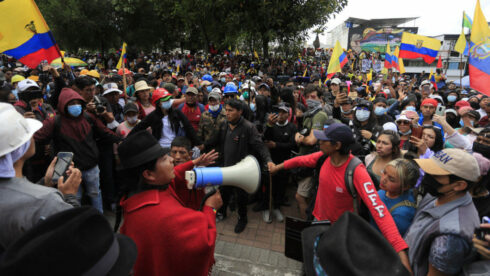
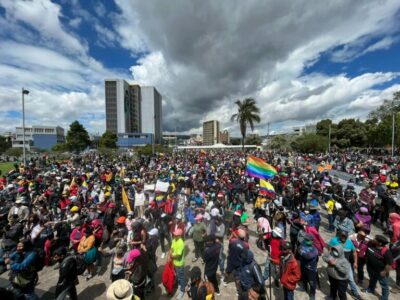
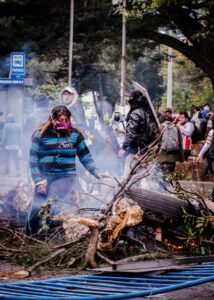
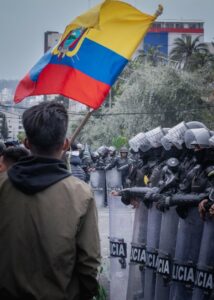
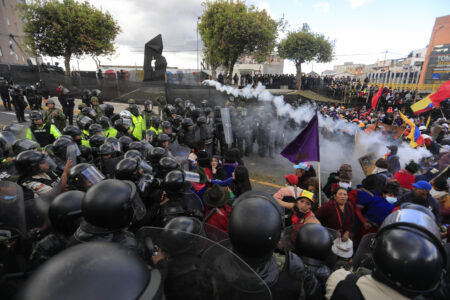
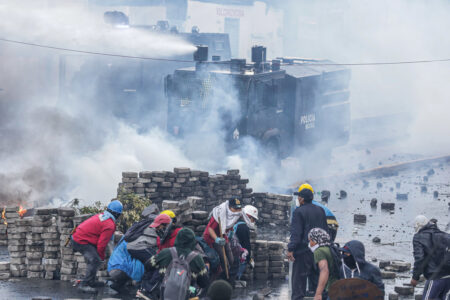
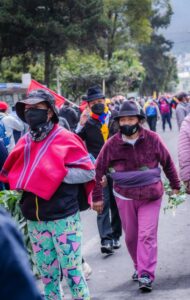



I protest in high heels and tranny miniskirt
Neo Liberal and Neo Conservative mean Jewish racist supremacism.
I’m lazy to read it all, is it revoluCIA or anti-revoluCIA?
Unfortunately, this populism will be used against them. When the left takes over, they’ll do the same things the right does re money/power.
that has already been done with the traitor lenin moreno,they will not fall for that trick,they are not stupid gringos
Unfortunately for your argument, Correa shows that to be wrong. Ecuador was in far better shape and the concerns of the people were met, he went after onerous debt and ditched the IMF. All very good steps. It was the liar Moreno, who claimed he would follow the same path. He turned out to be a Trojan horse owned by the same old criminals…the US/Israel. The people in the US thought they had the same type person in Trump, but he was yet another in a long line of owned phonies…owned by Israel who has been fomenting chaos all over the world through their proxie, the CIA. It didn’t take long for him to show his true self when it came to Venezuela. The ‘left’ you speak of is a phony meme set up by neocons to reinforce false claims.